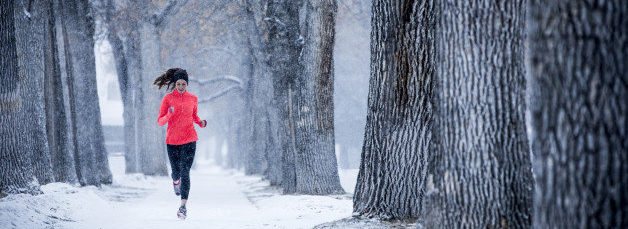Winter Safety Tips for Exercising Outdoors
Dressing in layers and paying attention to the forecast can help you stay safe and warm while exercising outdoors in cold weather.
Feeling de-motivated by freezing temperatures, ice, and snow? You aren’t alone. Winter weather tends to hinder the spirit of many active individuals. The lethargic feeling that often accompanies cold weather has a tendency to influence us to hibernate. However, you don’t have to let cold weather end your fitness routine. This article by Mayo Clinic has some tips for exercising in the cold.
The following tips are taken directly from this article
Stay safe during cold-weather exercise
If you have certain conditions, such as asthma, heart problems or Raynaud’s disease, check with your doctor first to review any special precautions you need based on your condition or your medications.
Check weather conditions and wind chill
Check the forecast before heading outside. Temperature, wind and moisture, along with the length of time that you’ll be outside, are key factors in planning a safe cold-weather workout.
Wind and cold together make up the wind chill, a common element in winter weather forecasts. Wind chill extremes can make exercising outdoors unsafe even with warm clothing.
The risk of frostbite is less than 5 percent when the air temperature is above 5° F (minus 15° C), but the risk rises as the wind chill falls. At wind chill levels below minus 18° F (minus 28° C), frostbite can occur on exposed skin in 30 minutes or less.
If the temperature dips below 0° F (minus 18° C) or the wind chill is extreme, consider taking a break or choosing an indoor exercise instead. Consider putting off your workout if it’s raining or snowing unless you have waterproof gear.
Know the signs of frostbite and hypothermia
Frostbite is an injury to the body that is caused by freezing. Frostbite is most common on exposed skin, such as your cheeks, nose and ears. It can also occur on hands and feet. Early warning signs include numbness, loss of feeling or a stinging sensation.
Immediately get out of the cold if you suspect frostbite. Slowly warm the affected area — but don’t rub it since that can damage your skin. Seek emergency care if numbness doesn’t go away.
Hypothermia is abnormally low body temperature. When exposed to cold temperatures, your body begins to lose heat faster than it can be produced. Exercising in cold, rainy weather increases the risk of hypothermia. Older adults and young children are also at greater risk.
Hypothermia signs and symptoms include intense shivering, slurred speech, loss of coordination and fatigue. Seek emergency help right away for possible hypothermia.
Dress in layers
Dressing too warmly is a big mistake when exercising in cold weather. Exercise generates a considerable amount of heat — enough to make you feel like it’s much warmer than it really is. The evaporation of sweat, however, pulls heat from your body and you feel chilled. The solution?
Dress in layers that you can remove as soon as you start to sweat and then put back on as needed. First, put on a thin layer of synthetic material, such as polypropylene, which draws sweat away from your body. Avoid cotton, which stays wet next to your skin.
Drink plenty of fluids
Don’t forget about hydration, as it’s just as important during cold weather as it is in the heat. Drink water or sports drinks before, during and after your workout, even if you’re not really thirsty.
You can become dehydrated in the cold from sweating, breathing, the drying power of the winter wind, and increased urine production, but it may be harder to notice during cold weather.
Putting it all together for cold-weather safety
These tips can help you safely — and enjoyably — exercise when temperatures drop. Closely monitor how your body feels during cold-weather exercise to help prevent injuries such as frostbite.







